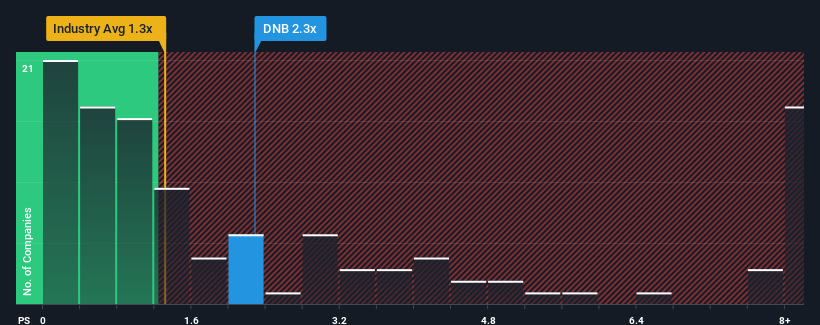- United States
- /
- Professional Services
- /
- NYSE:DNB
Dun & Bradstreet Holdings, Inc. (NYSE:DNB) Investors Are Less Pessimistic Than Expected

Dun & Bradstreet Holdings, Inc.'s (NYSE:DNB) price-to-sales (or "P/S") ratio of 2.3x may not look like an appealing investment opportunity when you consider close to half the companies in the Professional Services industry in the United States have P/S ratios below 1.3x. However, the P/S might be high for a reason and it requires further investigation to determine if it's justified.
Check out our latest analysis for Dun & Bradstreet Holdings

What Does Dun & Bradstreet Holdings' Recent Performance Look Like?
Recent times haven't been great for Dun & Bradstreet Holdings as its revenue has been rising slower than most other companies. Perhaps the market is expecting future revenue performance to undergo a reversal of fortunes, which has elevated the P/S ratio. However, if this isn't the case, investors might get caught out paying too much for the stock.
Want the full picture on analyst estimates for the company? Then our free report on Dun & Bradstreet Holdings will help you uncover what's on the horizon.How Is Dun & Bradstreet Holdings' Revenue Growth Trending?
Dun & Bradstreet Holdings' P/S ratio would be typical for a company that's expected to deliver solid growth, and importantly, perform better than the industry.
Taking a look back first, we see that there was hardly any revenue growth to speak of for the company over the past year. However, a few strong years before that means that it was still able to grow revenue by an impressive 36% in total over the last three years. Accordingly, shareholders will be pleased, but also have some questions to ponder about the last 12 months.
Looking ahead now, revenue is anticipated to climb by 4.6% each year during the coming three years according to the analysts following the company. With the industry predicted to deliver 9.0% growth each year, the company is positioned for a weaker revenue result.
In light of this, it's alarming that Dun & Bradstreet Holdings' P/S sits above the majority of other companies. It seems most investors are hoping for a turnaround in the company's business prospects, but the analyst cohort is not so confident this will happen. Only the boldest would assume these prices are sustainable as this level of revenue growth is likely to weigh heavily on the share price eventually.
What Does Dun & Bradstreet Holdings' P/S Mean For Investors?
It's argued the price-to-sales ratio is an inferior measure of value within certain industries, but it can be a powerful business sentiment indicator.
Despite analysts forecasting some poorer-than-industry revenue growth figures for Dun & Bradstreet Holdings, this doesn't appear to be impacting the P/S in the slightest. When we see a weak revenue outlook, we suspect the share price faces a much greater risk of declining, bringing back down the P/S figures. Unless these conditions improve markedly, it's very challenging to accept these prices as being reasonable.
There are also other vital risk factors to consider and we've discovered 3 warning signs for Dun & Bradstreet Holdings (1 can't be ignored!) that you should be aware of before investing here.
If these risks are making you reconsider your opinion on Dun & Bradstreet Holdings, explore our interactive list of high quality stocks to get an idea of what else is out there.
New: Manage All Your Stock Portfolios in One Place
We've created the ultimate portfolio companion for stock investors, and it's free.
• Connect an unlimited number of Portfolios and see your total in one currency
• Be alerted to new Warning Signs or Risks via email or mobile
• Track the Fair Value of your stocks
Have feedback on this article? Concerned about the content? Get in touch with us directly. Alternatively, email editorial-team (at) simplywallst.com.
This article by Simply Wall St is general in nature. We provide commentary based on historical data and analyst forecasts only using an unbiased methodology and our articles are not intended to be financial advice. It does not constitute a recommendation to buy or sell any stock, and does not take account of your objectives, or your financial situation. We aim to bring you long-term focused analysis driven by fundamental data. Note that our analysis may not factor in the latest price-sensitive company announcements or qualitative material. Simply Wall St has no position in any stocks mentioned.
About NYSE:DNB
Dun & Bradstreet Holdings
Provides business-to-business data and analytics in North America and internationally.
Good value with moderate growth potential.
Similar Companies
Market Insights
Community Narratives




